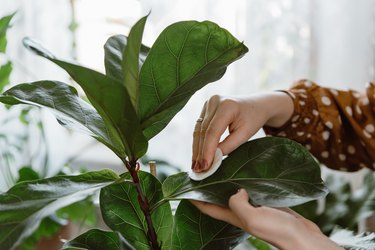
There are between 800 and 900 species of figs (Ficus spp.), which are native to Asia, Southeast Asia and Australia. Some ficus varieties grow as vines, while others are small shrubs or massive trees. Size and habit are just two of the ways in which the plants in this genus are diverse. Some ficus plants are deciduous and shed their leaves in the fall, while other ficus varieties are evergreen and keep their leaves all year.
Deciduous Types of Ficus
Video of the Day
The common fig (Ficus carica, zones 6-9) is a deciduous shrub with a height between 10 and 15 feet that is grown primarily for its sweet, edible fruit. With its silvery bark and 10-inch lobed leaves, this tree also has ornamental value. The leaves are dark green and have a somewhat rough texture on the upper surface but are smooth and have a lighter color underneath.
Video of the Day
The common fig produces green blooms in the spring, but the flowers are not very eye-catching. The fruit of the common fig tree is purple and shaped like a teardrop and has a honeylike sweetness and soft texture. Outside of its hardiness range, this shrub can be grown in containers and overwintered indoors.
Types of Ficus Trees
Another common type of fig plant, the weeping fig (Ficus benjamina, zones 10-12) is an evergreen species grown primarily as an ornamental plant on account of its gray-colored bark, dense crown of shiny green leaves and arched branches. While this tree can grow up to 50 feet tall in the wild, in cultivation, it is typically grown in containers, which limits its height to about 10 feet. This variety of fig is a popular indoor plant.
The Moreton Bay fig (Ficus macrophylla, zones 9-11), which is native to Australia, is a much larger tree than the weeping fig, with a height of up to 200 feet in the wild and 100 feet in cultivation. Named for the bay in eastern Australia where it grows, this ficus species has oval-shaped leaves that are shiny green on top and a brown color underneath.
Ficus Vine Species
Some ficus species grow as vines, like the climbing fig (Ficus pumila, zones 7-11), an evergreen with a length between 10 and 15 feet that features overlapping leaves and stems. This vine can climb on walls, trellises and other supports. The fruit of the climbing fig is pale green in color and not edible. The climbing ficus can be cultivated as an indoor plant where it is not winter hardy – it makes a good option for a hanging basket – but do not expect an indoor specimen to produce flowers or fruit indoors.
The climbing fig undergoes two stages of growth. In the juvenile phase, vines have 1-inch leaves with a wrinkly, paperlike texture. The leaves start as a burgundy color and change to bronze and copper before finally turning a dark green. Juvenile plants also have air rootlets that allow the vine to cling to surfaces. The plant adheres so well that some surfaces may be damaged if the vine is removed. Mature vines, on the other hand, have larger leaves with a leatherlike texture and lack the air rootlets present in juvenile vines.